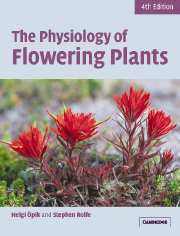Book contents
- Frontmatter
- Contents
- Preface
- Chapter 1 Introduction
- Part I Nutrition and transport
- Chapter 2 Flow of energy and carbon through the plant: photosynthesis and respiration
- Chapter 3 Water relations
- Chapter 4 Mineral nutrition
- Chapter 5 Translocation of organic compounds
- Part II Growth and development
- Appendix
- Index
- References
Chapter 3 - Water relations
Published online by Cambridge University Press: 05 June 2012
- Frontmatter
- Contents
- Preface
- Chapter 1 Introduction
- Part I Nutrition and transport
- Chapter 2 Flow of energy and carbon through the plant: photosynthesis and respiration
- Chapter 3 Water relations
- Chapter 4 Mineral nutrition
- Chapter 5 Translocation of organic compounds
- Part II Growth and development
- Appendix
- Index
- References
Summary
Introduction
Liquid water is absolutely necessary for life as we know it. Firstly it is the solvent and reaction medium of all living cells, which contain some 75–90% water by weight; secondly it is a reactant in many metabolic processes; and thirdly, as the hydration water of macromolecules, it forms part of the structure of protoplasm, existing as ‘liquid ice’ in a labile but ordered structure. The physicochemical properties of water (H2O) are unique; heavy water (D2O or DHO), containing deuterium, the heavy isotope of hydrogen, differs sufficiently to be toxic. In multicellular organisms, water provides the transport medium. Additionally, for plants, water is one of the raw materials for photosynthesis and produces the turgor pressure of water-filled vacuoles which gives mechanical rigidity to thin-walled tissues, while some movements of plant organs occur as a result of turgor pressure changes. Plant cell expansion is driven by turgor pressure and hence growth rates depend on hydration levels.
On ‘dry’ land, the highly hydrated body of a terrestrial plant in many situations tends to lose water to the environment, especially to the atmosphere, in accordance with gradients of free energy of water. There are few habitats where plants do not suffer some water shortage at least intermittently. The necessity for maintaining an adequate internal water content has been a major factor in the evolution of land plants with respect to structure and numerous aspects of physiology.
- Type
- Chapter
- Information
- The Physiology of Flowering Plants , pp. 60 - 99Publisher: Cambridge University PressPrint publication year: 2005



